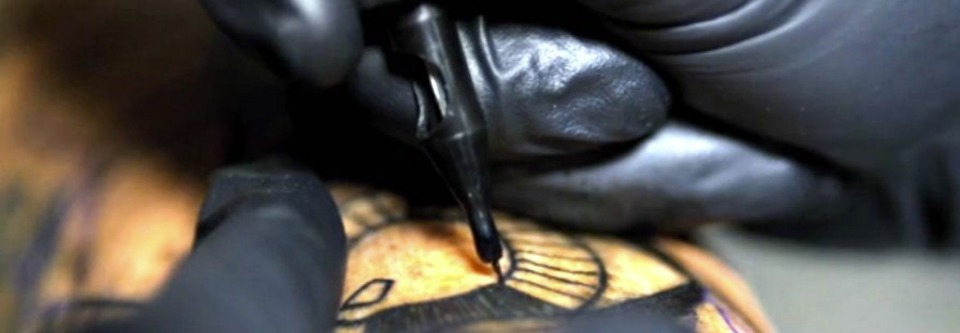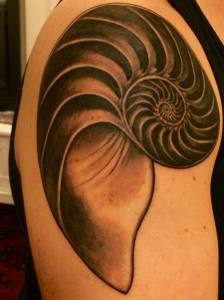
Last week I got a tattoo (my second tat, pictured above). This one is much larger and more intricate than my first so consequently I was in the chair much longer. All told it was about 3 1/2 hours for this one (in one sitting).
I mention this because it gave me a great opportunity to practice experiencing sensation. The tattoo artist repeatedly told me I was “taking it like a champ”. And while it is true I do have a high threshold for pain—I spent a lot of my youth getting pocked and prodded with needles as well as various painful medical procedures–I wasn’t just grinning and bearing it.
What allowed me to work through the experience was something more than just a high threshold or tolerance for pain. It’s one of the fruits of a kind of conscious bodily practice.
What do I mean by conscious bodily practice?
In order to answer that let’s start with clarifying a couple of terms: suffering and pain. For this context I would define suffering as what we do to avoid pain. It is what we add onto pain itself. (This isn’t always true but in this case I think this definition holds and it holds in many many other contexts as well). In this understanding suffering is more optional whereas pain is inevitable. In other words, one can experience pain without necessarily suffering.
This is a good first start but it’s not the final step because pain as it turns out isn’t as simple as pain.
Pain is itself (in many cases) an interpretation. What I mean is that it’s possible to get underneath pain–to befriend pain as my friend Irene Lyon would say. Pain can be broken down into constituent micro-sensations.
And this is what I did while being tattooed.
Pain is a word we have for a series of various sensations, mostly unpleasant sensations. If a person senses into the experience itself and takes off the interpretive filter of pain then it is possible for the pain to shift into other sensations.
So while I’m sitting being tattooed there were times where it was painful. There were plenty of other times where it was not.
Sometimes I would simply acknowledge I was experiencing pain and that was about that. I could still be talking to the tattooist, the other guys in the shop, listen to the music that was playing, or be working through something in my mind. A bit of pain but nothing overwhelming or particularly concerning.
Other times I wanted to explore the sensations I was calling pain. In those moments I felt into the sensations and then they stopped being pain.
When I really focused and felt and became curious about the sensations I found that what I otherwise reflexively call pain ended up being a much richer series of experiences and sensations.
I would simply become curious and name each sensation as it was occurring, Internally it would go like:
“scratching”
“tearing”
“clawing”
“burning”
“searing”
“oozing” (blood)
“zapping”
Then there was sensations I would describe as:
“throbbing”
“shooting”
“sharp”
“stretching”
“tightening”
I kept going:
“pulsing”
“twitching”
“rubbing”
“numbing”
When there would be temporary breaks in the process I would even feel:
“pleasure”
“release”
“relaxation”
At the most intense experiences during which I focused most deeply into the process, I even began to feel blissful. Blissful in what others would label pain.
I became so intensely focused at points that I actually forgot I was being tattooed (no joke!). I had my eyes closed and became so drawn into the sensations I really for a time lost the world around me or what was going on.
I opened my eyes up and was for a second was pretty startled until I remembered, “Oh yeah I’m getting a tattoo.”
Throughout the 3+ hours in the chair I would never once describe my experience as suffering. I never got caught in a mental whirl about how painful this all was and when would it be over and how much longer and oh god this is terrible and I can’t escape and I’m feeling trapped and please make it stop.
Didn’t happen.
I never suffered. I did experience plenty of pain but without much resistance to the pain itself. A few winches that was it. The most painful place was in the soft tissue on my curving towards my armpit. The second most tender place was along the ridge of my shoulder, where we touched some bone.
At those points especially I went into the pain and pain dissolved into other sensations–plenty of which were uncomfortable and unpleasant in various ways but intriguing and fascinating. Not in a masochistic kind of way but in a clarifying way.
Of course you don’t have to get tattooed to experience pain or more accurately unpleasant sensation. It’s part of our daily lives. Though if you are getting tattooed this is the way to do it trust me.
The good news here is that it’s very simple to reduce our suffering and enter our pain. By welcoming and entering our pain we can find our pain isn’t as simple as pain.
As I was walking home after the tattoo I could tell there were some blocked parts in my arm. Parts that felt as if they had been zapped or poked and had quickly contracted. All completely normal at the time no doubt.
The experience however was over yet these places felt as if they hadn’t relaxed from their contracted state. Like in grade school when kids would fake punching each other in the gut, the stomach naturally caves in as protection. But it was as if part of my arm was still caved in long after I realized the kid was only faking a punch. Or in this case actually sticking a needle into my flesh.
On the walk home, I let my arm start to gently move. It wanted to do this kind of almost popping up motion, with my shoulder raising and then lowering. As I did I began to feel energy and sensation moving and releasing, like electrical charges firing off.
Peter Levine says that pain is trapped sensation. It’s unfinished sensation, a kind of unfinished movement. By allowing the sensations to finish, allowing them to move as they wished–both during the tattooing and afterwards–my healing process has gone very smoothly. Little bits of residual soreness and tightness in some spots (to be expected) but overall doing wonderfully.
Anyone can learn this natural yet powerful way of relating to the sensations we describe as pain. Whether those are chronic types of pain or temporary periods of specific localized pain.
We release suffering by entering the pain (wisely) and the pain then itself dissolves into component sensations. We then learn to follow the impulses of those sensations bodily–flowing, rocking, swaying, loosening, as needed.
Healing results.
—
* Tattoo courtesy the awesome dudes at Sanitary Electric Tattoo here in Vancouver.

